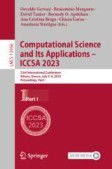Search
Search Results
-
QT-GILD: Quartet Based Gene Tree Imputation Using Deep Learning Improves Phylogenomic Analyses Despite Missing Data
Species tree estimation is frequently based on phylogenomic approaches that use multiple genes from throughout the genome. However, for a combination...
-
New evaluation methods of read map** by 17 aligners on simulated and empirical NGS data: an updated comparison of DNA- and RNA-Seq data from Illumina and Ion Torrent technologies
During the last (15) years, improved omics sequencing technologies have expanded the scale and resolution of various biological applications,...

-
Symphonizing pileup and full-alignment for deep learning-based long-read variant calling
Deep learning-based variant callers are becoming the standard and have achieved superior single nucleotide polymorphisms calling performance using...

-
Bioinformatics in Diagnosis of COVID-19
Improved diagnostics aided by AI and bioinformatics tools are playing a significant role in contributing to the ongoing coronavirus disease 2019...
-
Big Data Analytics in Bioinformatics
This chapter introduces the intricate interplay between big data analytics and bioinformatics, providing a comprehensive perspective on leveraging...
-
Object search by a concept-conditioned object detector
Object detectors are used for searching all objects belonging to a pre-defined set of categories contained in a given picture. However, users are...

-
Validating by Deep Learning an Efficient Method for Genomic Sequence Analysis: Genomic Spectrograms
Traditionally, comparative and simultaneous analysis of multiple genomic sequences is performed using multiple sequence alignment algorithms....
-
GPU-Accelerated Parallel Aligning Long Reads with High Error Rate Using Enhanced Sparse Suffix Array
The read alignment (sequence alignment) is one of the most basic and time-consuming problems in Bioinformatics. In this paper, a CPU-GPU parallel...
-
A GPU-Based Smith-Waterman Approach for Genome Editing
CRISPR is a mechanism used by archaea and bacteria to prevent virus attacks. The CRISPR-Cas9 technique was inspired by this natural genome editing...
-
Multi-GPU Approach for Large-Scale Multiple Sequence Alignment
Multiple sequence alignment is an important tool to represent similarities among biological sequences and it allows obtaining relevant information...
-
RattlesnakeJake: A Fast and Accurate Pre-alignment Filter Suitable for Computation-in-Memory
Significant improvements in pre-alignment filter accuracy have shifted the execution bottleneck of short-read sequence alignment to the filtering...
-
Co-linear Chaining with Overlaps and Gap Costs
Co-linear chaining has proven to be a powerful heuristic for finding near-optimal alignments of long DNA sequences (e.g., long reads or a genome...
-
Challenges for Healthcare Data Analytics Over Knowledge Graphs
Over the past decade, the volume of data has experienced a significant increase, and this growth is projected to accelerate in the coming years....
-
VisionKG: Unleashing the Power of Visual Datasets via Knowledge Graph
The availability of vast amounts of visual data with diverse and fruitful features is a key factor for develo**, verifying, and benchmarking...
-
Datashim and Its Applications in Bioinformatics
Bioinformatics pipelines depend on shared POSIX filesystems for its input, output and intermediate data storage. Containerization makes it more...
-
Sequence Analysis
Sequence analysis is a domain in bioinformatics which encompasses all computer-aided studies of biological sequence data. This data is produced from...
-
Extended Pairwise Sequence Alignment
A pairwise sequence alignment is a structure describing a set of editing operations that transforms one given sequence into another given sequence....
-
Investigating open reading frames in known and novel transcripts using ORFanage
ORFanage is a system designed to assign open reading frames (ORFs) to known and novel gene transcripts while maximizing similarity to annotated...

-
Graph-Based Representations for Supporting Genome Data Analysis and Visualization: Opportunities and Challenges
Genetics has known an extraordinary development in the last years, with a reduction of several orders of magnitude in the costs and the times...
-
Prolog Meets Biology
This paper provides an overview of the use of Prolog and its derivatives to sustain research and development in the fields of bioinformatics and...
